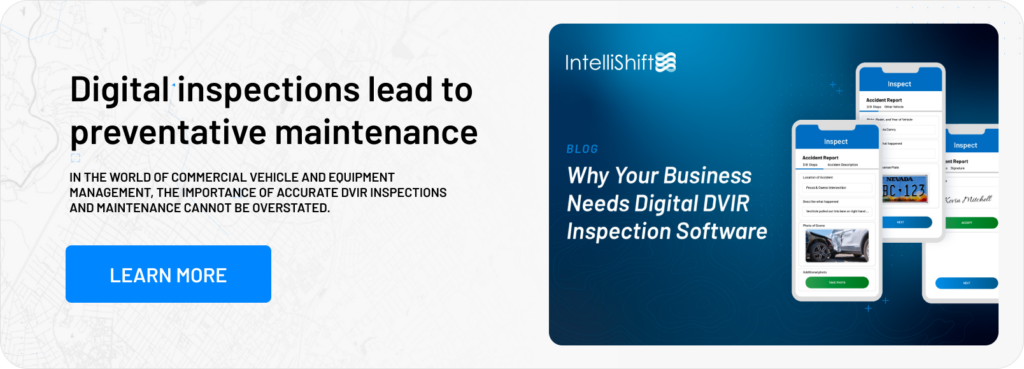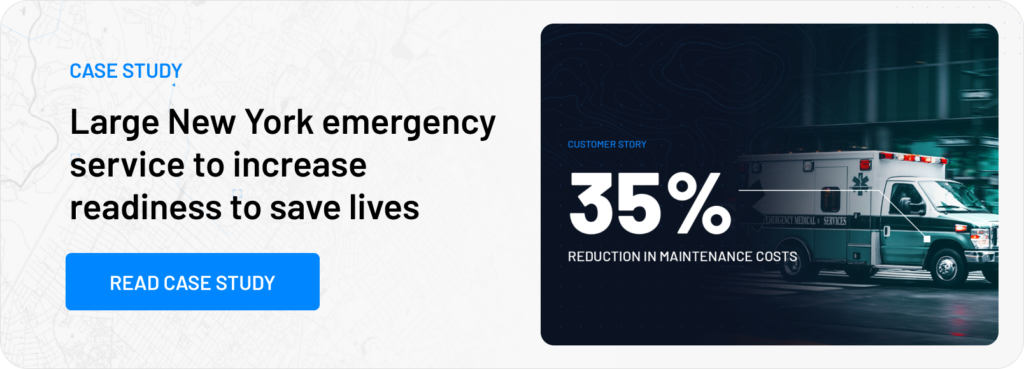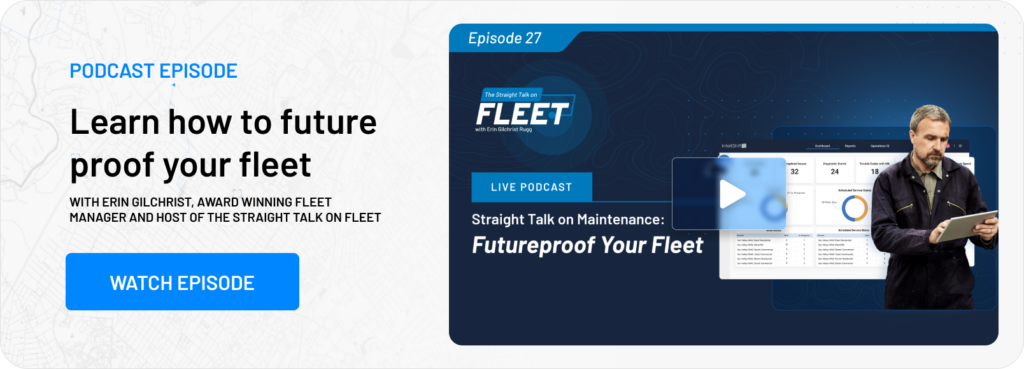Staying ahead in fleet means more than just keeping vehicles running efficiently, it’s having a maintenance strategy. As a fleet manager, you may be re-evaluating your current practice and asking, “how do I keep track of fleet maintenance?”, or you have a good grasp on maintenance, and you are ready to optimize your program. In either case, fleet maintenance software will help you reach your objectives. This guide will provide an intro to fleet maintenance software and how it can help your fleet. Then it will share how to choose the best fleet maintenance software for you and future trends to consider.
Understanding Fleet Maintenace Software
What is Fleet Maintenance Software?
Fleet maintenance software is a specialized digital solution designed to streamline and optimize the management of a fleet’s maintenance operations. It serves as a comprehensive tool for fleet managers and operators to monitor, schedule, and execute maintenance tasks efficiently. The primary goal of fleet maintenance software is to enhance the overall health and performance of a fleet by automating various aspects of maintenance, from scheduling routine services to tracking vehicle repairs and managing associated costs. Comprehensive programs improve compliance and are proactive and predictive in nature.
How it Aids in Vehicle Upkeep
Fleet maintenance software plays a crucial role in aiding vehicle upkeep by offering a range of features and functionalities that contribute to the overall health and longevity of a fleet. Here’s how fleet maintenance software supports vehicle upkeep:
- Automated Scheduling: Fleet maintenance software automates the scheduling of routine maintenance tasks based on factors such as time, mileage, or engine hours. This proactive approach helps prevent breakdowns and extends the lifespan of vehicles.
- Continuous Monitoring: The software provides real-time insights into the health and status of each vehicle in the fleet. This includes monitoring engine diagnostics and identifying potential issues as they arise.
- Alerts and Notifications: Fleet maintenance software can generate alerts and notifications for maintenance tasks, allowing fleet managers to address potential problems promptly.
- Accurate Inspections: Some fleet maintenance software includes digital inspection features, like DVIR, which enable accurate and thorough vehicle inspections. This ensures that all aspects of a vehicle are routinely checked, leading to early detection of issues.
- Efficient Task Assignment: The software facilitates the creation and assignment of work orders for maintenance tasks. This ensures that necessary repairs or inspections are assigned to the appropriate personnel and completed in a timely manner.
- Optimized Parts Availability: Fleet maintenance software helps manage spare parts and inventory efficiently. By tracking inventory levels and ordering parts as needed, the software ensures that necessary components are readily available, minimizing downtime.
- Comprehensive Data Analysis: Integration with telematics systems allows for the collection of real-time data on vehicle location, fuel consumption, and driver behavior. This integrated data enhances overall maintenance decision-making and efficiency.
By leveraging these features, fleet maintenance software transforms vehicle upkeep from a reactive and manual process into a proactive, data-driven, and streamlined operation, ultimately contributing to a well-maintained and reliable fleet. Predictive maintenance can show how trends and analytics drive future decisions.

Significance of Real-Time Tracking for Fleet Operations
Implementing fleet maintenance software offers a myriad of benefits for organizations managing vehicle fleets. These advantages contribute to improved fleet health, operational efficiency, and business matters. Here are some key business benefits:
- Proactive maintenance reduces the frequency of unexpected breakdowns, minimizing downtime and associated costs. Further, by using data insights from software, it can lead to improvements in fuel efficiency and thus cost savings. According to Fleet Owner, “fleets can see fuel consumption improvements in the 5% to 10% range when they implement a rigorous preventive maintenance program and then track and ensure PM compliance so that PM service is completed on all vehicles every time a PM service is scheduled.”
- Fleet maintenance software helps ensure that vehicles adhere to industry regulations and standards, avoiding penalties associated with non-compliance. Detailed maintenance records aid in audits and compliance reporting, providing a comprehensive history of each vehicle’s maintenance activities.
- The software provides valuable data and analytics on vehicle performance, maintenance costs, and other key metrics, enabling informed decision-making for fleet managers. Furthermore, it enables the tracking and analysis of maintenance costs, including labor, parts, and external services. This feature aids in budgeting, cost forecasting, and identifying areas for potential cost savings.
- Well-maintained vehicles lead to increased reliability, ensuring that services are delivered on time and meeting customer expectations. This ensures optimal vehicle uptime and allows you to exceed your customer’s expectations.

How to Keep Track of Fleet Maintenance
Effective fleet maintenance involves regular tracking, leveraging real-time monitoring through software, and customizing solutions to meet the specific needs of each fleet. According to Automotive Fleet, maintenance costs have been on the rise, but a good practice can help offset them. Fleet leaders can harness the power of fleet maintenance software to enhance efficiency, reduce downtime, and optimize maintenance practices for a safe, reliable, and cost-effective fleet.
The Importance of Regular Tracking
Regular tracking of fleet maintenance is pivotal for several reasons including preventative maintenance, cost control, and compliance. Regular tracking allows fleet managers to schedule preventative maintenance based on factors such as mileage, engine hours, and time intervals. This proactive approach helps avoid unexpected breakdowns and extends the lifespan of vehicles. Tracking maintenance activities enables the identification of patterns in repair and replacement needs. This insight aids in budgeting, cost forecasting, and optimizing expenses related to vehicle maintenance. Last but not least, regular tracking ensures that vehicles adhere to maintenance schedules mandated by industry regulations and standards. This is crucial for avoiding penalties and ensuring the safety and compliance of the fleet.
Utilizing Software for Real-Time Monitoring
Fleet maintenance software plays a key role in real-time monitoring because the software provides real-time data on the health and performance of each vehicle in the fleet. Fleet managers can access up-to-the-minute information on engine diagnostics, fuel consumption, and other critical metrics. Additionally, automated alerts and notifications are generated when the software detects issues or when scheduled maintenance is due. This ensures that fleet managers can address potential problems promptly, minimizing the risk of vehicle breakdowns. And lastly, advanced fleet maintenance software may use predictive analytics to forecast potential issues based on historical data. This foresight allows fleet leaders to take proactive measures before a problem escalates.
Customization for Specific Fleet Needs
Customization is key for fleet maintenance software to cater to the unique needs of each fleet because they vary in terms of vehicle types, usage patterns, and environmental conditions. The software should allow for the customization of maintenance schedules to align with the specific requirements of each vehicle in the fleet. Customization extends to user roles and permissions within the software. Fleet managers should have the flexibility to grant access and permissions based on the responsibilities and roles of different team members. Most importantly, the fleet maintenance software should easily integrate with existing systems (e.g., telematics, ERP) to ensure seamless operations. Customization options should accommodate these integrations to create a cohesive and interconnected fleet management ecosystem.
Setting Up a Fleet Maintenance Program
A Comprehensive Approach to Implementation
Establishing a robust fleet maintenance program demands a strategic and systematic approach. Begin with a thorough assessment of your fleet, creating a comprehensive inventory that includes crucial details about each vehicle. Define maintenance protocols based on industry standards, manufacturer recommendations, and the specific requirements of your fleet. Choosing the right fleet maintenance software is paramount—select a solution that aligns seamlessly with your fleet’s needs, offering customization, real-time monitoring, and integration capabilities.
Once the foundational elements are in place, develop a meticulous maintenance calendar outlining scheduled tasks and inspections. Assign responsibilities clearly, ensuring that roles related to scheduling, inspections, and repairs are well-defined. Implement reporting mechanisms for ongoing analysis, allowing you to track trends, assess costs, and make informed decisions. The key to a successful program lies in continuous improvement, fostering a culture that regularly evaluates and refines maintenance protocols based on real-world experiences. Work Truck Magazine offers a great step by step guide to get you started.
Seamlessly Integrating Fleet Maintenance Software
Integrating fleet maintenance software into existing processes requires a thoughtful transition plan. Collaborate with the software provider to facilitate smooth data migration and ensure seamless integration with other systems, such as telematics and ERP solutions. Customize the software to align with your workflow, avoiding disruptions to established practices. Implement comprehensive training sessions to familiarize personnel with the new software, providing ongoing support and feedback mechanisms for a successful integration.
In parallel, focus on user support and create avenues for users to share their experiences and insights. This collaborative approach ensures that the software not only becomes an integral part of daily operations but also evolves based on user feedback. By combining effective integration with user-focused strategies, organizations can harness the full potential of fleet maintenance software while preserving the efficiency of their existing processes.
Training and Onboarding for Success
The success of a fleet maintenance program hinges on the knowledge and proficiency of the personnel involved. Develop structured training programs covering software usage, maintenance protocols, and safety procedures. Implement a thorough onboarding process for new team members, introducing them to the fleet maintenance software and its role in daily operations. Foster ongoing training opportunities to keep personnel updated on new features and advancements, encouraging skill development and certifications. Establish knowledge transfer mechanisms, creating mentorship programs that facilitate collaboration and expertise sharing within the maintenance team. Through a commitment to training and onboarding, organizations can ensure that their personnel are well-equipped to maximize the benefits of fleet maintenance software, contributing to a more efficient and reliable fleet.
Choosing the Best Fleet Maintenance Software
Factors to Consider in Selecting the Right Software
When selecting fleet maintenance software, it’s crucial to consider several key factors to ensure alignment with the unique needs of your fleet. Start by evaluating the scalability of the software—choose a solution that can grow alongside your fleet and adapt to changing requirements. Integration capabilities are equally important; the chosen software should seamlessly integrate with existing systems, such as telematics and enterprise resource planning (ERP) solutions, to create a cohesive and interconnected fleet management ecosystem. Customization options play a pivotal role, allowing you to tailor the software to your specific workflow and operational processes. Additionally, prioritize user-friendliness, as an intuitive interface ensures that your team can quickly adopt and leverage the software effectively. Consider the vendor’s reputation, support services, and ongoing maintenance and update policies to ensure a reliable and long-term partnership.
Futureproof Your Fleet Management
It’s essential to futureproof your fleet by selecting software that embraces emerging technologies and industry trends. Keep an eye on developments in fleet intelligence, as advancements in data analytics and connected technologies continue to shape the future of fleet management. Consider participating in webinars to stay informed about the latest trends and innovations. By choosing a forward-thinking fleet maintenance software solution, you not only meet your current needs but also position your fleet for success in the dynamic landscape of tomorrow’s fleet management.

Future Trends in Fleet Maintenance Software
Fleet Intelligence
The future of fleet maintenance software is intricately tied to the integration of fleet intelligence, a transformative trend shaping the industry. Fleet intelligence involves harnessing the power of data analytics and advanced algorithms to gain deeper insights into fleet operations. This data-driven approach allows fleet managers to make informed decisions, optimize maintenance schedules, and predict potential issues before they escalate. By leveraging fleet intelligence, maintenance becomes more proactive and strategic, leading to improved operational efficiency and cost savings.
Emerging Technologies and Their Impact
The impact of emerging technologies, particularly artificial intelligence (AI), is a pivotal trend revolutionizing fleet maintenance. AI is reshaping how maintenance tasks are approached, with predictive maintenance being a standout application. By analyzing vast amounts of data from vehicles and equipment, AI can predict when components are likely to fail, enabling proactive maintenance interventions. This not only decreases downtime but also optimizes resource allocation, contributing to a more efficient and cost-effective fleet.
Industry Predictions for 2024 and Beyond
Looking ahead to 2024 and beyond, industry experts predict several noteworthy developments in fleet maintenance software. These include advancements in telematics, IoT (Internet of Things), and cloud-based solutions. Telematics integration will become even more prevalent, offering real-time tracking, diagnostics, and connectivity. The IoT will play a crucial role in creating a more interconnected fleet, allowing for seamless communication between vehicles, devices, and maintenance systems. Additionally, the continued adoption of cloud-based solutions will enhance accessibility, scalability, and collaboration within fleet management. Staying abreast of these predictions ensures that fleet leaders can align their strategies with the evolving landscape, positioning their fleets for success in the years to come.
Say Goodbye to Fleet Maintenance Challenges!
In summary, fleet maintenance software offers a comprehensive solution to the challenges of managing and maintaining a fleet of vehicles. The resulting benefits include cost savings, improved efficiency, and a fleet that is more reliable and compliant with industry standards. Business should not just consider where they are today, but in what ways they need to change or grow, then select the right technology partner. IntelliShift brings experience in partnering with fleets across the country to solve their challenges and preparing for the future with its single connected platform.





![Episode 50 Thumbnail Erin celebrates building the fleet community with 50 episodes and 11K followers on LinkedIn [Podcast]](https://intellishift.com/wp-content/uploads/2024/01/Fleet-Maintenance-Blog-Cover.png)



